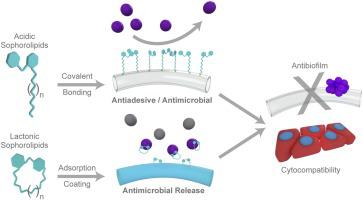Colloids and Surfaces B: Biointerfaces ( IF 5.4 ) Pub Date : 2021-08-23 , DOI: 10.1016/j.colsurfb.2021.112057 Rita M Mendes 1 , Ana P Francisco 1 , Filomena A Carvalho 2 , Maissa Dardouri 1 , Bruna Costa 3 , Ana F Bettencourt 1 , Judite Costa 1 , Lidia Gonçalves 1 , Fabíola Costa 3 , Isabel A C Ribeiro 1

|
Staphylococcus aureus medical devices related-infections, such as blood stream catheter are of major concern. Their prevention is compulsory and strategies, not prone to the development of resistance, to prevent S. aureus biofilms on catheter surfaces (e.g. silicone) are needed. In this work two different approaches using sophorolipids were studied to prevent S. aureus biofilm formation on medical grade silicone: i) an antiadhesive strategy through covalent bond of sophorolipids to the surface; ii) and a release strategy using isolated most active sophorolipids.
Sophorolipids produced by Starmerella bombicola, were characterized by UHPLC-MS and RMN, purified by automatic flash chromatography and tested for their antimicrobial activity towards S. aureus. Highest antimicrobial activity was observed for C18:0 and C18:1 diacetylated lactonic sophorolipids showing a MIC of 50 μg mL−1. Surface modification with acidic or lactonic sophorolipids when evaluating the anti-adhesive or release strategy, respectively, was confirmed by contact angle, FTIR-ATR and AFM analysis. When using a mixture of acidic sophorolipids covalently bonded to silicone surface as antiadhesive strategy cytocompatible surfaces were obtained and a reduction of 90 % on biofilm formation was observed. Nevertheless, if a release strategy is adopted with purified lactonic sophorolipids a higher effect is achieved. Most promising compound was C18:1 diacateylated lactonic sophorolipid that showed no cellular viability reduction when a concentration of 1.5 mg mL−1 was selected and a reduction on biofilm around 5 log units. Results reinforce the applicability of these antimicrobial biosurfactants on preventing biofilms and disclose that their antimicrobial effect is imperative when comparing to their antiadhesive properties.
中文翻译:

用槐糖脂对抗金黄色葡萄球菌导管相关感染:选择抗粘连策略还是释放策略?
金黄色葡萄球菌相关感染的医疗器械,如血流导管,是主要关注的问题。它们的预防是强制性的,并且需要不易产生耐药性的策略,以防止导管表面(例如硅胶)上的金黄色葡萄球菌生物膜。在这项工作中,研究了两种不同的使用槐糖脂的方法来防止在医用级有机硅上形成金黄色葡萄球菌生物膜:i) 通过槐糖脂与表面共价键合的抗粘附策略;ii) 和使用分离的最活跃槐糖脂的释放策略。
Starmerella bombicola 生产的槐糖脂通过 UHPLC-MS 和 RMN 进行表征,通过自动快速色谱纯化,并测试它们对金黄色葡萄球菌的抗菌活性。对于 C18:0 和 C18:1 双乙酰内酯槐糖脂观察到最高的抗菌活性,MIC 为 50 μg mL -1. 分别通过接触角、FTIR-ATR 和 AFM 分析证实了在评估抗粘连或释放策略时用酸性或内酯槐糖脂进行的表面改性。当使用共价键合到有机硅表面的酸性槐糖脂混合物作为抗粘附策略时,获得了细胞相容性表面,并且观察到生物膜形成减少了 90%。然而,如果对纯化的内酯槐糖脂采用释放策略,则可以获得更高的效果。最有希望的化合物是 C18:1 二乙酸化内酯槐糖脂,当浓度为 1.5 mg mL -1时,该化合物没有显示细胞活力降低被选中,生物膜减少约 5 个对数单位。结果加强了这些抗菌生物表面活性剂在预防生物膜方面的适用性,并表明与它们的抗粘附特性相比,它们的抗菌作用是必不可少的。











































 京公网安备 11010802027423号
京公网安备 11010802027423号